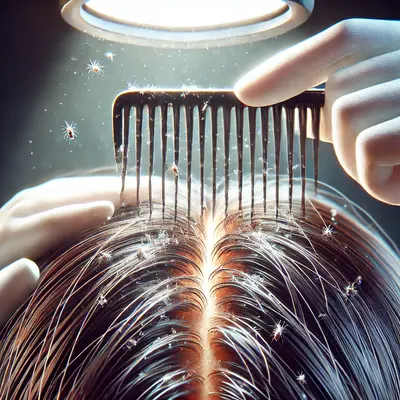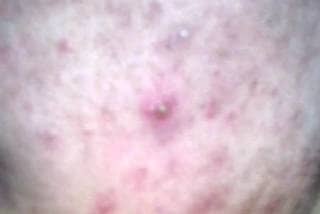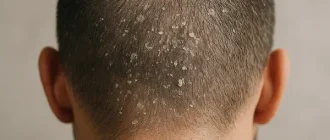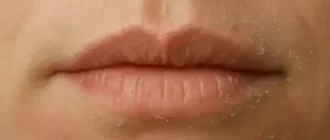When you experience an itchy scalp, it can be alarming and uncomfortable. Dandruff and lice are two common culprits, but they require very different treatments. Identifying the cause is the first step toward effective relief.
Symptom Comparison: Dandruff vs. Lice
| Symptom | Dandruff | Lice |
|---|---|---|
| Itching | Moderate | Severe |
| Flakes/Nits | Loose flakes | Firmly attached nits |
| Redness or Sores | Occasional | Frequent |
| Movement | None | Visible |
| Contagion | No | Yes |
This table highlights the key differences between dandruff and lice symptoms to aid in accurate identification and treatment, with visual bar indicators for severity.
Understanding Dandruff: Causes and Symptoms
Dandruff is a scalp condition characterized by flaking skin. It’s not contagious and often results from:
- Seborrheic dermatitis:
- What it is: A chronic skin condition causing oily, irritated, and flaky patches on the scalp.
- Symptoms: Flakes may appear greasy and yellowish; redness can occur in severe cases.
- Example: A 30-year-old man in New York noticed greasy flakes on his scalp, particularly near his hairline and eyebrows. A dermatologist diagnosed seborrheic dermatitis and recommended a medicated shampoo.
- Treatment effectiveness: Medicated shampoos with selenium sulfide or ketoconazole often reduce symptoms by 70-80% with consistent use.
- Cost: $10–$20 per bottle.
- Dry skin:
- What it is: A temporary condition often triggered by cold, dry weather.
- Symptoms: Flakes are small, white, and tend to fall off easily. The scalp may feel tight or itchy without visible redness.
- Example: A 25-year-old woman from Chicago experienced increased flaking during winter. Switching to a moisturizing shampoo resolved her symptoms in weeks.
- Treatment effectiveness: Hydrating shampoos and conditioners can reduce symptoms by 80%.
- Cost: $8–$15 per bottle.
- Yeast overgrowth (Malassezia):
- What it is: A naturally occurring fungus that can irritate the scalp when overactive.
- Symptoms: Flakes are often oily and yellowish. Itching may worsen after sweating or wearing hats.
- Example: A 40-year-old man in Texas found his dandruff worsened after exercising. Using an antifungal shampoo improved his condition within two weeks.
- Treatment effectiveness: Antifungal shampoos are 85% effective with regular use.
- Cost: $12–$18 per bottle.
- Product irritation:
- What it is: Sensitivity to certain ingredients in shampoos, conditioners, or styling products.
- Symptoms: Flaking and redness occur soon after using a new product. Itching is localized.
- Example: A 19-year-old student in California developed dandruff-like symptoms after switching to a heavily fragranced shampoo. Discontinuing the product resolved her symptoms.
- Treatment effectiveness: Symptoms resolve within days of discontinuing the irritant.
- Cost: Varies, depending on replacement products.
Symptoms of Dandruff:
- White or yellow flakes:
- Flakes are loose and fall easily, often noticeable on shoulders or clothing.
- Flakes may be more pronounced after brushing or scratching.
- Itchiness:
- Commonly linked to dryness or irritation.
- Itching intensifies after using certain products or in dry weather.
- Oily or greasy patches:
- Scalp may feel slick or unclean, especially near the hairline.
Dandruff is manageable with medicated shampoos containing active ingredients like selenium sulfide or zinc pyrithione.
What Are Lice?
Head lice are parasitic insects that live on the scalp and feed on blood. They spread through direct head-to-head contact and occasionally through shared personal items like hats or combs.
Symptoms of Lice Infestation:
- Itching: Persistent itching, especially at the nape of the neck and behind the ears, caused by an allergic reaction to lice bites. If the itching worsens at night, it could indicate lice activity, as they are more active in the dark.
- Visible lice or nits: Lice are tiny, moving insects, typically grayish-white or brown, about the size of a sesame seed. Nits (eggs) are oval, yellowish-white, and firmly attached to hair shafts close to the scalp. Unlike dandruff, nits don’t flake off easily.
- Red bumps or sores: Small, red bumps or sores may appear on the scalp, neck, or shoulders due to bites or excessive scratching. These sores can sometimes become infected if not treated promptly.
- Tickling sensation: Some individuals report feeling a crawling or tickling sensation on their scalp, indicating lice movement.
Key Differences Between Dandruff and Lice
| Feature | Dandruff | Lice |
|---|---|---|
| Cause | Skin condition or yeast | Parasitic insects |
| Contagious | No | Yes |
| Appearance of flakes | Loose, white, or yellow | Nits are oval and firmly attached |
| Movement | None | Lice can move |
| Treatment | Medicated shampoos | Lice combs, medicated treatments |
Real-Life Case: A Child, 8, from California
A mother noticed her 8-year-old child constantly scratching their head. At first, she thought it was dandruff and used over-the-counter dandruff shampoo. However, the child continued to scratch, and small red bumps appeared along the hairline. Upon closer inspection, the mother found tiny white nits stuck to the hair shafts. A pediatrician confirmed it was lice, and the family treated it with a lice-killing shampoo and thorough combing.
Expert Advice
Reyus Mammadli, a health care advisor, emphasizes the importance of accurate identification: “Misdiagnosing lice as dandruff can delay treatment and lead to further spread. If you’re unsure, consult a healthcare professional or pharmacist.” He also notes that maintaining scalp hygiene and using preventative measures can reduce the risk of both conditions.
Practical Tips for Diagnosis and Treatment
- Check under bright light:
- Method: Use a fine-tooth comb and inspect your scalp carefully under bright light.
- Details: Look for moving insects or attached nits, which are oval-shaped and firmly attached to hair shafts near the scalp.
- Effectiveness: Highly effective for identifying lice but not dandruff.
- Cost: Minimal (typically the cost of a comb, around $5–$10).
Wash and treat appropriately:
- Method for Dandruff: Use medicated shampoos containing selenium sulfide, zinc pyrithione, or ketoconazole.
- Method for Lice: Apply lice-specific treatments such as permethrin or pyrethrin-based shampoos.
- Effectiveness: Shampoos for dandruff can reduce flakes by up to 80% when used consistently; lice treatments are 95% effective when applied correctly.
- Cost: Dandruff shampoos range from $8–$15, while lice treatments cost around $20–$30 per kit.
Prevent lice spread:
- Method: Avoid sharing personal items such as hats, brushes, pillows, or bedding.
- Details: Clean household items thoroughly if an infestation is identified.
- Effectiveness: Essential for stopping the spread of lice in households or schools.
- Cost: Typically no additional cost, as it’s behavior-based.
When to seek professional help:
- When to Act: If over-the-counter remedies fail, symptoms worsen, or there is significant discomfort.
- Who to Consult: Visit a dermatologist or pediatrician for advanced treatment options or prescription shampoos.
- Effectiveness: Professional treatments often resolve symptoms completely within a few weeks.
- Cost: Consultation fees range from $100–$300 depending on insurance and location.
Treatment Success Rates: Dandruff vs. Lice
| Treatment Method | Success Rate (%) |
|---|---|
| Medicated Shampoos for Dandruff | 80% |
| Lice Combs with Medicated Treatment | 95% |
| Natural Remedies for Dandruff | 60% |
| DIY Lice Removal (No Medication) | 50% |
This chart visually represents the success rates of various treatment methods for dandruff and lice, helping users choose the most effective solutions.
Editorial Advice
Addressing scalp issues promptly is crucial for comfort and confidence. For dandruff, choose the right shampoo and adjust your hair care routine. For lice, act quickly to prevent spreading. Always consult a professional when in doubt, and remember that both conditions are treatable with proper care.
About the Author
Reyus Mammadli is the author of this health blog since 2008. With a background in medical and biotechnical devices, he has over 15 years of experience working with medical literature and expert guidelines from WHO, CDC, Mayo Clinic, and others. His goal is to present clear, accurate health information for everyday readers — not as a substitute for medical advice.







